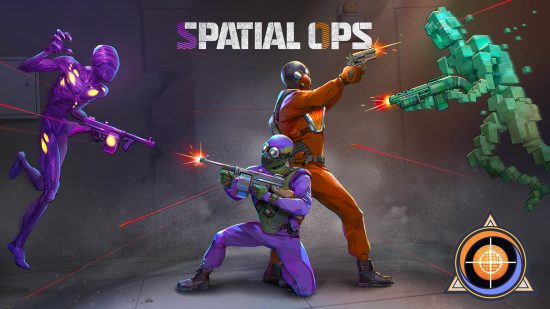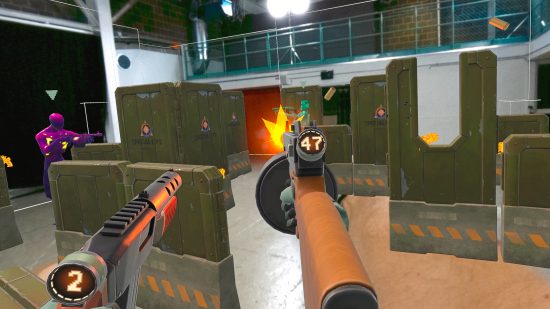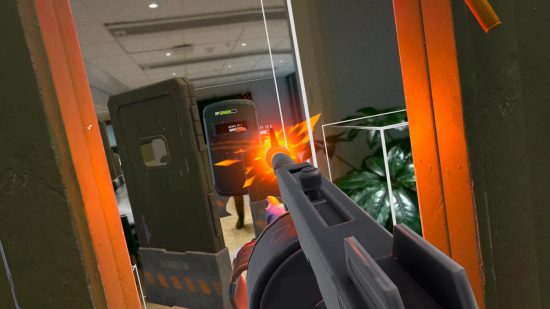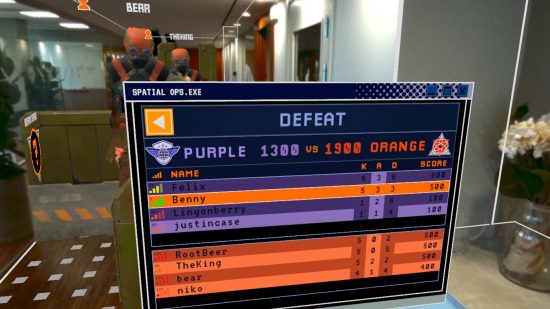The Meta Quest Pro isn’t your standard VR headset. Targeting business users with a price point to match, this hasn’t stopped developers from taking advantage. Thanks to several features not on Meta Quest 2 (formerly Oculus Quest 2) like colour passthrough or eye and facial tracking, we’re seeing studios getting creative. Between Blaston, Cubism, and Demeo, more games are delivering mixed reality (MR) experiences, merging VR with augmented reality (AR) to merge virtual gameplay with the real world. Spatial Ops by Resolution Games might be MR’s most convincing case yet.
Launching on Meta Quest Pro and Meta’s best VR headset, Quest 2, Resolution describes Spatial Ops as “the world’s first competitive multiplayer shooter in mixed reality.” Produced by Niklas Persson, former designer on Codename Eagle and Battlefield 1942, Spatial Ops turns real-life spaces into an FPS. Speaking with CEO Tommy Palm during a recent visit to Resolution’s office, he explained their vision, telling me “it was always a dream to have a Counterstrike-like game in real life.”
Supporting 1-8 players, I soon tested the game on both Quest headsets across two hours, alongside the Demeo mixed reality update. While AI fights are an option, me and the other visitors played 3v3 matches across an open hall. Spatial Ops achieves this through colocation, which lets headsets recognise each other’s presence.
While this technology isn’t exclusive to Quest, this lets developers place virtual objects at specific locations across a defined area. When asked about VR and MR’s development differences, Palm advises that “some things are very similar, some things are very different. You can’t really do it at your computer, you have to test much more intently.”
Between digital walls and gun locations, this means every player sees the same thing, and Spatial Ops can be played across any indoor location. It doesn’t matter if you’re using an office, your living room, or somewhere unconventional; you can create maps to fit any environment. Sadly, I didn’t get to try mapping out the arena directly, Resolution set everything up. But once you’ve defined a map’s parameters and weapon spawn locations, you’re good to go.
Spatial Ops comes with three gameplay modes. There’s your classic Team Deathmatch and Capture The Flag, alongside a domination mode where you’d fight to hold three control points. Resolution Games isn’t pushing the boat here, but it didn’t matter. What’s impressive here is the actual gameplay. Spatial Ops feels like mixed reality laser tag, which is unsurprising after Palm told me Persson once ran a laser tag arcade. Unlike VR games, death doesn’t transport you to a spawn area. You must physically retreat to your team’s safe zone, waiting several seconds before rejoining.
Between hiding around virtual walls, grabbing digital items, and staking out opponents, it didn’t take long to acclimatise. Weapons were scattered around the map, ranging between revolvers, grenades, RPG launchers, machine guns, and more. Sometimes riot shields and health items would spawn, offering extra protection when pressing forward. However, there’s nothing penalising you for walking through digital barriers, which is understandable as that’d be tricky to enforce.
As someone who doesn’t play many FPS games, this feels like a revelation. Other players aside, the physical space in front of me was empty, yet I’d instinctively hide around virtual walls like they were actually there. Because you’re physically moving and seeing your real-world surroundings, I never felt nauseous like I often have with artificial locomotion in VR. I couldn’t fault the sense of presence in mixed reality, and I had great fun with Spatial Ops.
This wouldn’t be possible with Quest’s passthrough mode, which projects your real-world surroundings through your headset. If you’ve ever set up a Guardian boundary in Quest 2 to define your play space, you’ll recognise this. On Quest Pro, your surroundings are viewed with colour passthrough. Unsurprisingly, Pro feels better than Quest 2, which only supports black and white passthrough, but I never felt disadvantaged on Meta’s older headset.
Despite losing almost every match, I didn’t want to stop playing, and I came away thoroughly impressed by Spatial Ops. The only real downside is that larger matches require more extensive play areas, which won’t always be practical for those playing at home. Palm admits this is a problem, calling testing when focusing on space “very intense,” later admitting “it’s tricky to do this concept in an open landscape like this.”
Still, there’s versatility in Spatial Ops design that shows colocation and passthrough’s potential in mixed reality gaming. I felt completely immersed, more so than I’ve often felt with VR shooters, and I’m excited to give this another try. Spatial Ops doesn’t have a confirmed release date, but if you’re curious to jump in, an open beta test has just gone live via SideQuest.



